Puerto Rican cycads are very intriguing! Dr. Alan Meerow and colleagues, including Montgomery staff, have just published a paper in the American Journal of Botany detailing the results of extensive fieldwork and labwork focused on the Zamia native to Puerto Rico.
Three species — Zamia erosa, Zamia pumila, and Zamia portoricensis — are native to the island, giving Puerto Rico a quite diverse cycad flora relative to its land area. Zamia erosa occurs on the northern side of the island, while Z. portoricensis and Z. pumila occur in the south. This study shows that all three species are genetically distinct, with Z. pumila and Z. portoricensis possibly derived from a common ancestral species on the island, and Z. erosa representing an independent introduction to the island. The three species also show different patterns of diversification. One population of Zamia erosa appears to undergoing strong natural selection currently, perhaps due to a more saline habitat. This type of selection has been seen elsewhere in Zamia, and may lead to shorter, thicker leaflets, much like those of Zamia furfuracea. Another very interesting possibility discussed is that these species may have  been transplanted between islands by humans for use of the tuberous stems for food.
been transplanted between islands by humans for use of the tuberous stems for food.
Populations assigned to Zamia pumila also occur in the Dominican Republic and Cuba, while some populations in Cuba and Jamaica have been referred to Z. erosa. Additional analyses of samples collected on other islands will clarify whether these populations occurring on separate islands belong to the same species, or have separately evolved similar morphology.
American Journal of Botany is the one of the leading publications for current botany research, and is published by the Botanical Society of America. This study is the latest finding of the Caribbean Zamia Project, which is a collaborative effort of USDA Chapman Field, MBC, FIU-FTBG, and NYBG. The research was generously supported by the National Science Foundation, and a Christiane Tyson Research Fellowship.
November 2012
Fall/Winter
2012 Montgomery Botanical News is Now Online!
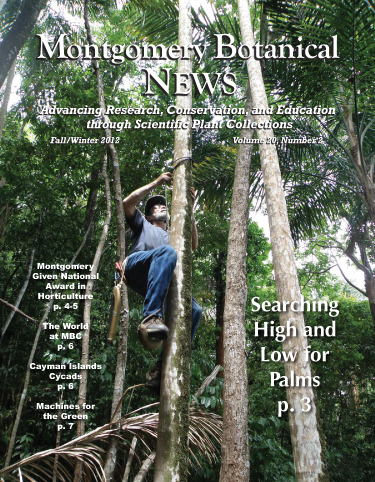 This new issue has articles about a palms in Dominica and French Guiana, cycads in the Cayman Islands, and new agricultural equipment that we have been testing. It
also highlights the Horticultural Landmark Award that MBC was given by the American Society for Horticultural Science.
This new issue has articles about a palms in Dominica and French Guiana, cycads in the Cayman Islands, and new agricultural equipment that we have been testing. It
also highlights the Horticultural Landmark Award that MBC was given by the American Society for Horticultural Science.
Please see the back cover for information on two national grants MBC received this year and the exhibit on Montgomery Botanical Center that will be on display at the Coral Gables Museum in January and February of 2013.
Montgomery Botanical Center
publishes two newsletters a year to keep our supporters and
collaborators up to date and informed.
To read more about how
Montgomery Botanical Center meets our mission of "Advancing Research,
Conservation, and Education through Scientific Plant Collections"
please see our newsletters online.
November 1, 2012
Sacher Family Generously Restores 1932 Montgomery Greenhouse
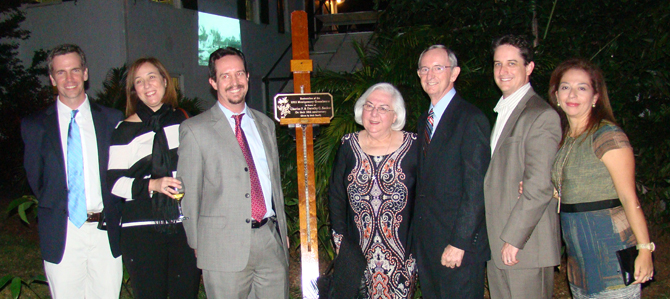
The Montgomery Board, Members, and supporters gathered on the evening of November 1st to honor the family of Charles and Dorothy Sacher, who generously funded the restoration of the 1932 Montgomery Greenhouse.
The original greenhouse was built for Colonel Montgomery in 1932, the same year he established his plant collection and built his home in Coral Gables. Over the last 80 years, the greenhouse has continuously served the Montgomery mission — most every plant in the collection started out as a seedling in that greenhouse.
Careful assessment by a preservation architect, provided by the Conservation Assessment Program, determined that critical repairs were needed to ensure the 1932 structure could continue its important service.
Charles and Dorothy’s sons and their families — Charles S. and Ana Sacher, Richard and Annamaria Sacher, and John and Ana Sacher — provided the full support needed for this important work, in honor of Charles and Dorothy’s 50th wedding anniversary.
We greatly appreciate the great leadership shown by Charles S. Sacher, his brothers, and their wives in providing this generous support. Please join us in thanking the Sacher family, and congratulating Charles and Dorothy on their golden anniversary!
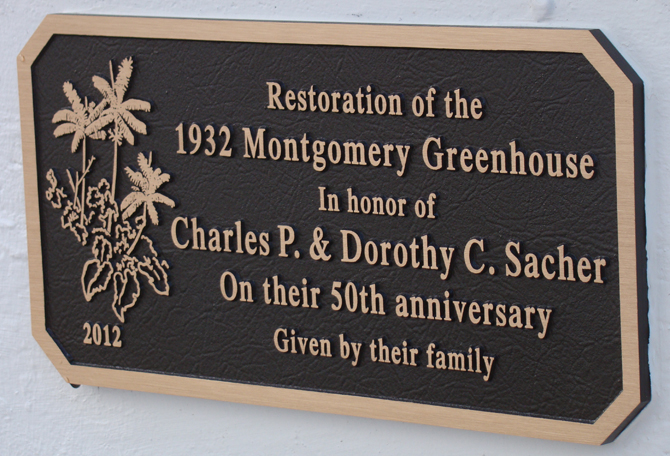
October 5, 2012
Dr. Nura Abdul Karim to Give Talk on
The Singapore Botanic Gardens
Title: The Singapore Botanic Gardens
Speaker: Dr. Nura Abdul Karim, Plant Records Manager, Living Collection Division, Singapore Botanic Gardens
Date: Friday, October 5 at 2:30 PM
Location: Nixon Smiley Meeting Room, Montgomery Botanical Center (Refreshments will be provided)
The beauty, horticulture and science of a pre-eminent tropical botanic garden: Founded in 1859, the Singapore Botanic Gardens today encompasses 183 acres of beautiful tropical gardens and lakes, as well as facilities for botanical science, horticulture, education, the arts and visitor services. The garden encourages public access to a unique degree, being perhaps the only garden in the world that is open from 5 AM to 12 midnight every day of the year, with no admission fee except for admittance the National Orchid Garden. The garden also includes a small virgin tropical rainforest with massive rainforest trees. Among the countless outstanding plants in the garden is a fruiting specimen of the Coco de Mer, Lodoicea maldivica.
Singapore Botanic Gardens' mission: "Connecting people and plants through publications, horticultural and botanical displays, educational outreach, and events, provision of a key civic and recreational space, and playing a role as an international Gardens and a regional centre for botanical and horticultural research and training."
Beginning in 2011, the Montgomery Botanical Center and Singapore Botanical Gardens have established a plant and staff exchange that has fostered collaboration between our gardens and enhanced our collections.
About the speaker: Dr. Nura Abdul Karim completed her Ph.D. in Horticulture at the University of Western Australia studying fungal relationships with tropical orchids. Currently she heads the Plant Records Unit of the Singapore Botanic Gardens where she oversees the garden's database and ensures proper use of the collection for research and display. She is also a member of the Scientific Committee of the newly formed Pha Ta Ke Botanic Garden in Laos and along with other international researchers assists in training and aid in an advisory capacity for the staff there.
This lecture is made possible with the support of the City of Coral Gables.
September 25, 2012
Fieldwork for a New Sabal species
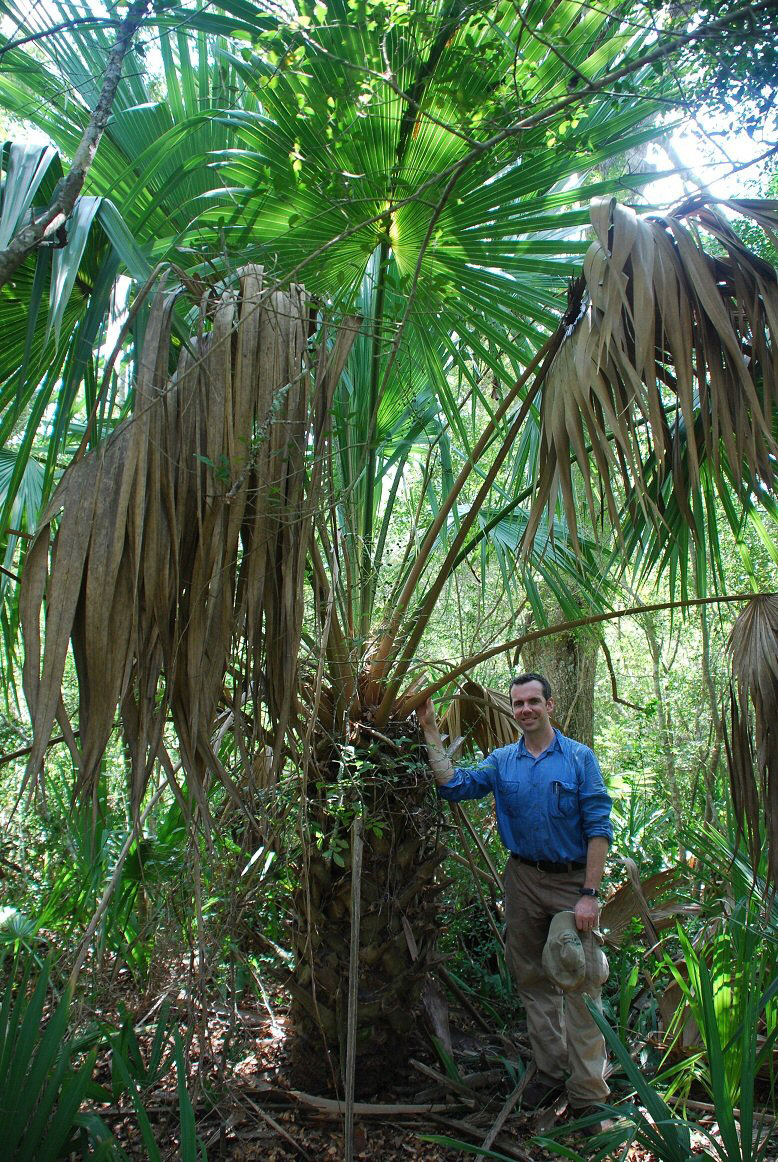 Recently, Dr. Doug Goldman of the USDA determined that the unusually robust palms in Brazoria County, Texas were actually a new hybrid species, Sabal x brazoriensis, the result of an ancient cross between S. minor and probably S. palmetto.
Recently, Dr. Doug Goldman of the USDA determined that the unusually robust palms in Brazoria County, Texas were actually a new hybrid species, Sabal x brazoriensis, the result of an ancient cross between S. minor and probably S. palmetto.
Montgomery has one of the most extensive living collections of Sabal palms known, but this new hybrid species was not among them. So, this past week, MBC Executive Director Dr. Patrick Griffith teamed up with Doug, Mr. Thomas Adams of the US Fish and Wildlife Service, and Col. Michael Griffith to study and collect these unique palms.
Perhaps only a few hundred Brazoria Palms survive in the wild. Fortunately, most of these thrive in a single 45-acre forest of oaks and elms, which was recently protected as part of the San Bernard National Wildlife Refuge. The team collected seeds, herbarium specimens, and photographs, which will help conserve and document this very rare natural hybrid species.
Montgomery is grateful to Thomas for his time, knowledge and expertise, the Paul Drummond Fund for Palm Conservation for funding this fieldwork, the US Fish and Wildlife Service for permission to collect the palms, and to Mike and Sylvia Griffith for hospitality and logistical support.
September 24, 2012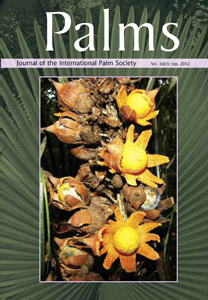
Fieldwork by Montgomery’s Palm Biologist Featured in Palms
Dr. Larry Noblick’s recent research and conservation fieldwork in French Guiana was featured in the journal Palms, Volume 56(3). The cover photo for the recent issue features the unusual fruits of Astrocaryum paramaca, one of the species Larry studied there recently.
The article by Larry recounts his explorations of the native palm flora there, especially in search of the stemless Attalea palms. Very little is currently known about these species.
Palms is the journal of the International Palm Society, and features peer-reviewed articles on palm biology, diversity, and horticulture.
September 1, 2012
Short films about Montgomery Botanical Center
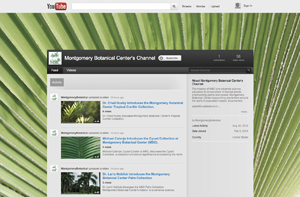 In February of 2012 James Clugston, MBC Botanical Research Fellow from Royal Botanic Garden Edinburgh, was inspired to develop Montgomery TV to educate the public around the world about MBC's research collections.
In February of 2012 James Clugston, MBC Botanical Research Fellow from Royal Botanic Garden Edinburgh, was inspired to develop Montgomery TV to educate the public around the world about MBC's research collections.
Montgomery Botanical Center now has a YouTube channel, Montgomery TV. On Montgomery TV you can see short films about different plants in the collection.
"I developed the concept of Montgomery TV to help communicate the fascination and beauty of the collections and science that have made such an impact on me and others who visit," said James.
Chad Husby, MBC Collections Manager, saw the potential for this medium: "Visitors to MBC often express surprise that they had not heard of such a beautiful and world class garden sooner, sometimes calling it a "well kept secret." Montgomery TV provides a powerful tool for raising public awareness of the garden and the exciting botanical work being done here."
Executive Director Patrick Griffith states, "I was thrilled to see that James Clugston brought this additional talent - filmmaker - to the Research Fellows Program. Having James showcase the botanical work we are doing, in moving pictures, is an added bonus."
Please visit Montgomery TV on YouTube; take a look at the films and subscribe to our channel.
The Kelly Botanical Research Fellows program at MBC is generously funded by the Kelly Foundation. This program brings established experts and early-career botanists to Montgomery to work with the plant collection and the Montgomery Team.
August 4,
2012
Montgomery
Botanical Center
Receives National Award in Horticulture
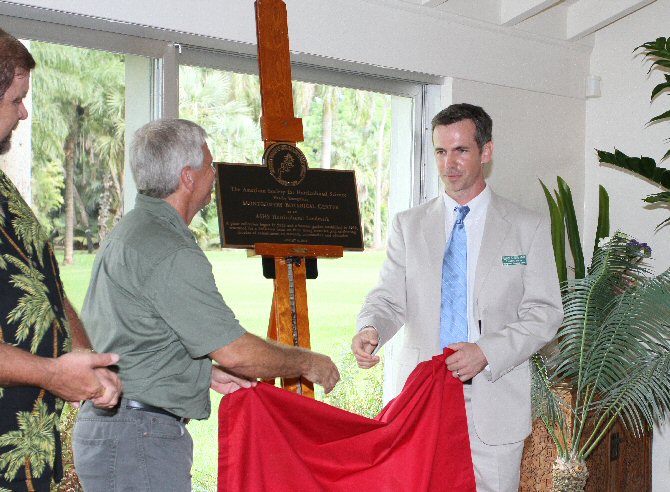
Montgomery
received
the Horticultural
Landmark Award from the American
Society for Horticultural Science (ASHS) on August 4, 2012
The
award recognizes some of Montgomery’s best strengths. Quoting from the
ASHS:
“. . . general criteria for consideration include:
permanence of site; proper documentation of the horticultural
collection, including origins; an
underlying scientific basis for collections; [and] monitoring and
labeling of plants.”
This is a very big
achievement for Montgomery – previous recipients of this honor are few,
and include some of the most prominent botanic gardens – The New York
Botanical Garden, Missouri Botanical Garden, and the Arnold Arboretum,
for example.
In presenting the award,
Dr. George Fitzpatrick, chair of the ASHS award committee, highlighted
Colonel Robert Montgomery’s record of significant philanthropy in
support of plants, not only at MBC, but at NYBG, Greenwich, and FTBG as
well. ASHS Executive Director Dr. Michael Neff spoke to the recent
contributions to plant science that are helped by MBC and its team, and
ASHS committee member Dr. Michael Arnold offered examples of MBC’s work
to develop early-career horticulture professionals – including his own
students.
The award refers to
Montgomery’s origins, stating:
“A
plant collection begun in 1932 and a
botanic garden established in 1959, renowned
for a dedicated focus on
these living treasures, and
celebrating decades of commitment to research, conservation and
education.”
MBC Executive Director
Dr. Patrick Griffith made brief remarks to acknowledge Montgomery’s
founders, board, staff, volunteers, colleagues, and supporters -- and
singled out the visiting scientists from Canada, Scotland, and New York: "As
evidence that we have an exceptional plant collection, note that they
are all here in Miami, In August."
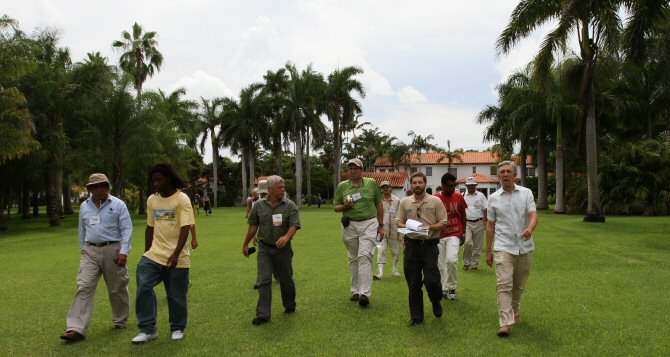
July 2012
Botany,
Horticulture and Gardens:
Sharing
Montgomery’s Work at Annual Conferences
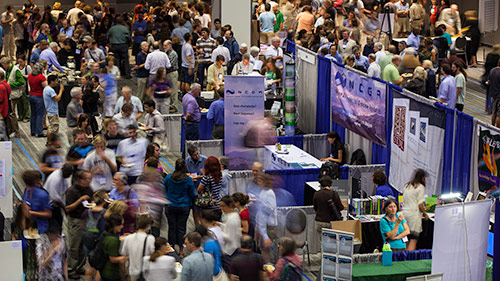 This
summer, the MBC Team presented Montgomery’s work at a series of local,
national, and international conferences.
This
summer, the MBC Team presented Montgomery’s work at a series of local,
national, and international conferences.
First on the list was the Florida
State Horticulture Society Annual Meeting, held in
Delray Beach. Patrick Griffith was invited to speak at the Horticulture
Breakfast, by FSHS President (and MBC Board Member) Dr. Juanita
Popenoe. Patrick gave a talk titled, "21st century botanic gardens: new
challenges and opportunities."
This year’s meeting of the
American Public Gardens Association – "Garden
Paths"– was held in Columbus, Ohio. Patrick presented a case study
of how horticulture and economics can help with plant conservation. Please
see here for the online slideshow.
The Botanical Society
of America’s Botany
2012 Conference was also hosted in Columbus. Quite a few speakers
at Botany 2012 acknowledged the use of plants here at Montgomery,
showing how our living plant collection can help advance science. MBC
staff were also authors or co-authors on these talks on palms and
cycads:
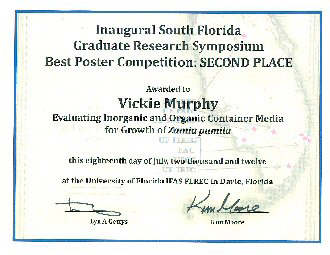 The
2012 ESRI International
User Conference in San Diego displayed MBC work as well, as part of
the Alliance for Public Gardens GIS. Ericka Witcher’s work to adapt
remote sensing data for botanic garden use was included in their
display.
The
2012 ESRI International
User Conference in San Diego displayed MBC work as well, as part of
the Alliance for Public Gardens GIS. Ericka Witcher’s work to adapt
remote sensing data for botanic garden use was included in their
display.
Finally, Vickie Murphy (MBC
Nursery Curator) attended both the South Florida Graduate
Research Symposium, in Fort Lauderdale, and the American
Society for Horticultural Science Annual
Conference, which was held here in Miami. Vickie presented the
results of her Master’s Thesis project to improve conservation
horticulture for rare Zamia species – and her poster won an
award!
“I’m thrilled to see how much
great work is going on here at Montgomery, and how our service to the
plant community can also help promote other research and innovations,”
said Patrick. "This may be our best summer yet."
July 27, 2012
Exploring
and Collecting the Flora of the Dominican Republic
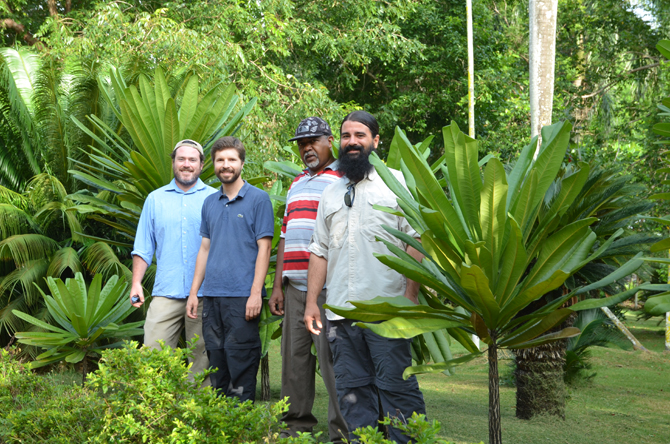
A
collaborative effort of three botanical gardens resulted in a very
successful expedition to the Dominican Republic (DR) from July 16-26.
More than 100 species of living plants were collected by the team for
scientific and ornamental cultivation, ranging from palms to conifers
and the giant horsetail (a fern relative). The expedition was supported
by a generous donation from Lin Lougheed.
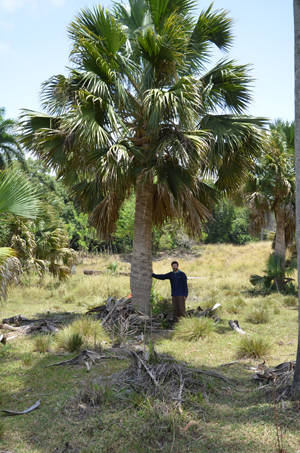 Dr.
Chad Husby (Collections Manager and Botanist) of MBC teamed up with Dr.
Brett Jestrow (Herbarium Curator) and Jason Lopez (Living Collection
Manager) of Fairchild Tropical Botanic Garden (FTBG) at the invitation of
Ricardo Garcia, Director General of Jardín Botánico
Nacional Dr. Rafael Ma. Moscoso de Santo Domingo (JBSD), to explore for plants in the
Dominican Republic as part of an ongoing tradition of collaboration
among these institutions. Francisco Jiménez Rodríguez
(Botanical Department Director) and Alberto Veloz (Herbarium Curator)
of the JBSD coordinated the visit. Expert botanist Teodoro Clase of
JBSD accompanied the MBC and FTBG staff in the field and guided them
with great skill.
Dr.
Chad Husby (Collections Manager and Botanist) of MBC teamed up with Dr.
Brett Jestrow (Herbarium Curator) and Jason Lopez (Living Collection
Manager) of Fairchild Tropical Botanic Garden (FTBG) at the invitation of
Ricardo Garcia, Director General of Jardín Botánico
Nacional Dr. Rafael Ma. Moscoso de Santo Domingo (JBSD), to explore for plants in the
Dominican Republic as part of an ongoing tradition of collaboration
among these institutions. Francisco Jiménez Rodríguez
(Botanical Department Director) and Alberto Veloz (Herbarium Curator)
of the JBSD coordinated the visit. Expert botanist Teodoro Clase of
JBSD accompanied the MBC and FTBG staff in the field and guided them
with great skill.
The island of Hispaniola, of
which the Dominican Republic comprises two thirds, is floristically
rich with over 5,000 native plant species, many of which are endemic.
This expedition focused on endemic palms and other flowering plants of
the island. Special highlights included Reinhardtia paiewonskiana,
the only Reinhardtia palm species native to the Caribbean and
a new genus for the collections at MBC and FTBG. Sabal domingensis
is another new introduction to the botanical palm collections in South
Florida.
A remarkably rare and
ornamental tree, Clavija domingensis, was given to MBC and
FTBG by the JBSD, probably the first time this species has been
introduced to cultivation outside Hispaniola. This beautiful palm-like
tree is represented by at most two surviving individuals in Haiti, but
is under protective cultivation and propagation at JBSD. Furthermore
the primeval giant horsetail, Equisetum giganteum, the only
horsetail in the Caribbean, was collected in the Cordillera Central.
The breadth and depth of this expedition and its combination of local
and international collaboration hearkens back to the early days of the
botanical institutions in South Florida. No doubt Robert Montgomery and
David Fairchild would be very pleased with the outcome.
July 23, 2012
MBC Awarded
IMLS-Museums for America Grant
 The U. S. Institute of Museum and
Library Services (IMLS) awarded
Montgomery Botanical Center a generous federal
grant to support collections stewardship.
The U. S. Institute of Museum and
Library Services (IMLS) awarded
Montgomery Botanical Center a generous federal
grant to support collections stewardship.
This grant will fund research to
develop a plan for managing MBC’s population-based collection of
cycads, a group of woody plants found in the subtropical and tropical
parts of the world and at risk for extinction.
The collaborative project team
will use proven genetic assay techniques to assess the genetic
diversity of a botanic garden cycad collection, and then incorporate
this information into collections planning for future work devoted to
cycad and palm conservation.
Project results will be shared
broadly with plant researchers, botanical gardens, research facilities,
and the public through websites, tours, educational programming,
conferences, reports, and scientific and popular publications.
Montgomery will partner with the
USDA
Agricultural Research Service Subtropical Horticulture Research Station
and Botanic Gardens Conservation International U.S. (BGCI U.S.) to conduct this
research, which will directly improve the management of MBC’s Cycad
Collection, and help other botanic garden conservation efforts.
July 20, 2012
Palm
Fieldwork in Dominica
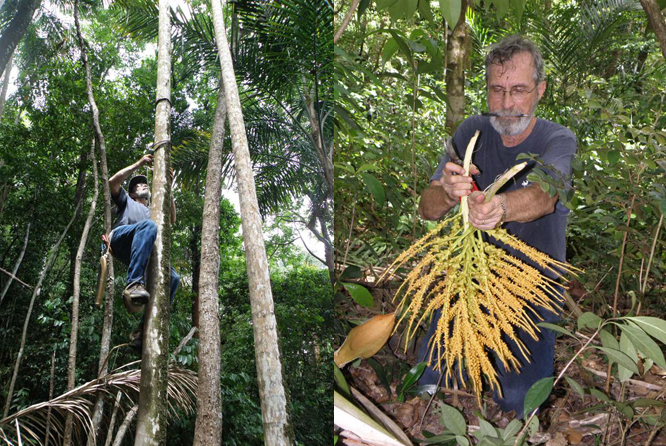
Dr. Larry Noblick, MBC Palm
Biologist, just returned from an 11-day expedition on the island of
Dominica. He has returned with preserved specimens for scientific study
and over 800 seeds for the living conservation collections.
Dominica is home to at least 10
species of palm. Larry’s interest was not only in seeing all of these
species in the field, but especially those that would be in fruit this
time of year. He was also interested in gathering genetically important
seed samples from these populations for conservation purposes,
especially Syagrus amara, which is his focus of research.
Larry reports that Dominica has some of the largest forests of Syagrus
amara that he has witnessed anywhere in the eastern Caribbean
(left see Larry climbing a tall Syagrus).
On the right, Larry splits an
inflorescence of Syagrus amara to make a voucher specimen; a
duplicate of which was left at the Archibold Tropical Research and
Education Center in Dominica along with some seed.
This project was generously
funded by the Paul Drummond Fund for Palm Conservation and would not
have been as successful without the collaboration of the Dominican
Division of Forestry and the generosity of the Division of Agriculture.
Special thanks to retired forester, Arlington James, who collaborated
with Larry on this fieldwork project.
June 21, 2012
New
Discoveries by the MBC Team Featured in PALMS
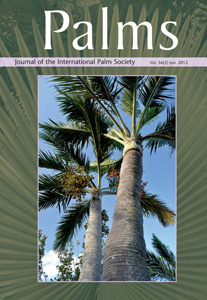 A new
hybrid palm and a ‘hidden’ island palm – the MBC team reports two new
discoveries in the latest issue of PALMS.
A new
hybrid palm and a ‘hidden’ island palm – the MBC team reports two new
discoveries in the latest issue of PALMS.
Larry Noblick, MBC Palm
Biologist, has described a new hybrid species, Syagrus x mirandana.
This Brazilian savanna palm is a hybrid between S. coronata
and S. microphylla. The trunkless palm resembles a grass,
with a long, spikelike flower shoot which rises high above the
grasslike foliage. Over the course of fieldwork in Brazil, Larry has
discovered much new diversity in palms, and this new hybrid is another
fascinating example of how palms have adapted to grassland
environments.
Also reported here is a new
population of Pseudophoenix sargentii from Mona Island (see
January 23, below). Conservation concerns over these palms prompted
Patrick Griffith (MBC Executive Director) to team up with botanists
from Puerto Rico and FIU-Fairchild (Eugenio Santiago, Jose Sustache and
Javier Francisco-Ortega) to assess these unique plants. The newly
discovered population on Mona is notable for its striking appearance,
and is featured on the cover of this issue, PALMS 56(3).
PALMS is the journal of the International Palm Society,
presenting peer-reviewed botany and horticulture on the palm family
since 1956.
June 1, 2012
National
Science Foundation award supports Living Plant Collections at MBC
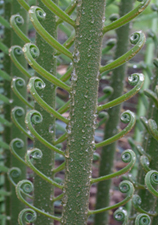
 Montgomery
was recently awarded
a grant by the National Science Foundation. The grant will provide
modern environmental controls for living plants to further enhance
MBC’s collection for the scientific community. Quoting from the NSF’s
evaluation:
Montgomery
was recently awarded
a grant by the National Science Foundation. The grant will provide
modern environmental controls for living plants to further enhance
MBC’s collection for the scientific community. Quoting from the NSF’s
evaluation:
“This is one of the most
important collections of cycads and palms in the world, both in terms
of species representation and genetic diversity. The collection is
heavily used by the scientific community.”
Plants from Montgomery are extensively
used by scientists and many NSF-funded projects have used plant
material from MBC collections. Montgomery is well known for commitment
to detailed plant records, dedicated horticulture, and service to the
research community.
May 15, 2012
Palm
Fieldwork in French Guiana
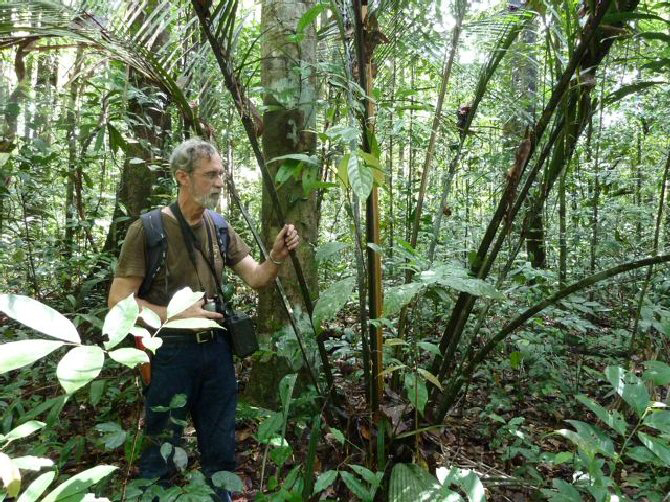
Dr. Larry Noblick, MBC Palm
Biologist, just returned from a month-long botanical expedition in
French Guiana, returning with many important preserved specimens and
seeds for living conservation collections.
Larry’s focus on this project
was the acaulescent (stemless) Attalea palms, many of which
occur in Northern South America. This group of palms has not been
thoroughly examined – Larry reports that these palms do not often
flower in the deep shade of the forest understory (please see the
example in the upper photo). Larry also obtained collections of Syagrus
inajai, an important addition to MBC’s Syagrus
collection.
Below, Larry is pictured with
Jean-Jacques de Granville and Sophie Gonzalez reviewing specimens in
the Herbier de Guyane
(CAY).
This project was generously
funded by Lillian Fessenden and the Paul Drummond Fund for Palm
Conservation.
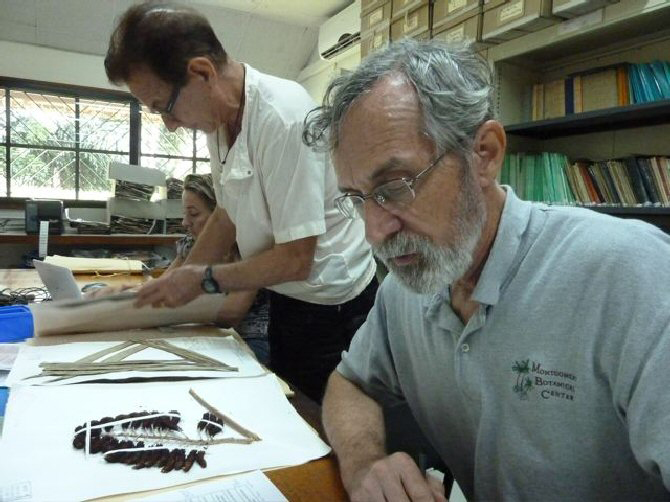
May 13, 2012
Fieldwork
for Zamia in the Cayman Islands
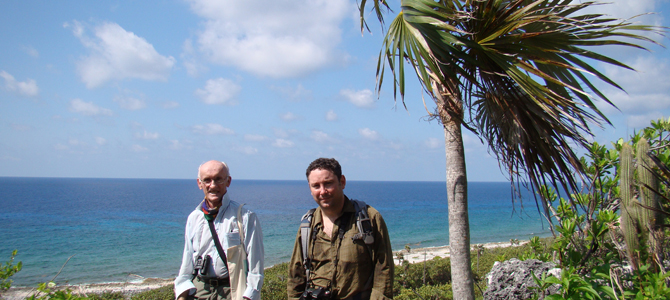
Montgomery scientists worked
with botanists in the Cayman Islands over the past week to survey,
document and collect specimens of Zamia integrifolia. As part
of the Caribbean Zamia Project, leaflet samples from Grand Cayman,
Little Cayman, and Cayman Brac – over 150 samples – were prepared for
DNA analysis.
Patrick Griffith and Michael
Calonje are very grateful for the collaboration of John Lawrus from the
Queen Elizabeth II
Botanic Park, Fred Burton from the Blue Iguana Recovery Program, and
Wallace Platts (pictured here with Michael) of the National Trust for the Cayman
Islands, who each participated in fieldwork. With the help of these
experts, the project team now has a thorough sample of the genetic
diversity in these cycads, which are locally called ‘bullrush.’
The Cayman Islands are
biogeographically important, located south of Cuba and west of Jamaica.
Many intriguing species are only found in these three remote islands,
such as the Silver Thatch Palm, Coccothrinax proctori
(pictured). Given this unique flora and geography, the bullrush from
these islands is essential to understanding cycad diversity in the
region.
The Caribbean Zamia Project is a
collaborative effort led by Florida
International University, the USDA
Agricultural Research Service, the New
York Botanical Garden, and Montgomery, along with collaborators
throughout the Caribbean. Fieldwork in the Cayman Islands was funded by
the National
Science Foundation.
Please see Montgomery’s recent newsletters
for further information about the project.
April 27, 2012
MBC
Champion Trees Celebrated for Arbor Day
April 27 is National Arbor Day, which
celebrates trees and tree planting. So, today, Miami’s National Public
Radio station, WLRN
91.3 FM, interviewed the MBC team about one of MBC’s
Champion Trees, the Barbados Silver Palm (Coccothrinax
barbadensis). You
can hear the broadcast here.
This individual tree was planted
for Colonel Montgomery, and has thrived at MBC for 80 years – making it
the largest specimen in the United States, and recognized as the
Florida State Champion.
Many of Montgomery’s Champion
Trees were initially located using aerial images and GIS. For Arbor
Day, the experts at ESRI recently
built an application that allows everyone to explore and view the
Champion Trees at MBC. You can explore the Champions in the map below,
or go and see the map here.
Please take a look at MBC’s Champion
Trees Page for more information.
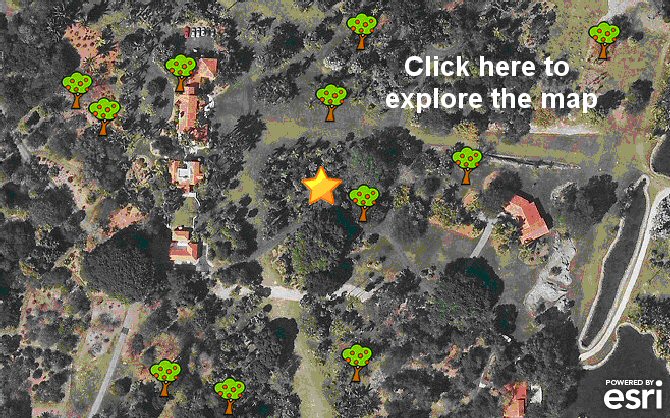
April 17, 2012
Montgomery
Hosts South Florida Botanic Gardens for Sentinel Plant Network
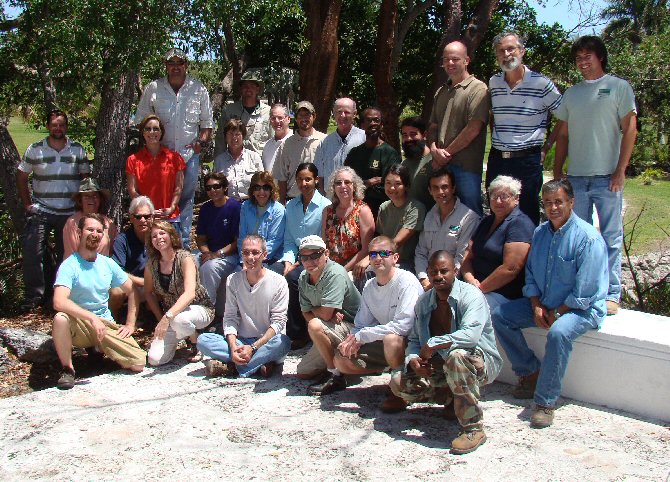
MBC and other botanic gardens
have vitally important plant collections. At times, these gardens must
cope with new insect pests and new pathogens. Thankfully, a new
partnership – the Sentinel
Plant Network – is devoted to helping gardens with this critical
work.
MBC was delighted to host
horticulture colleagues from Vizcaya,
The
Wertheim Conservatory, USDA Chapman
Field, Fairchild,
and as far away as Naples
Botanical Garden for a one-day workshop on the Sentinel Plant
Network. At the workshop, participants worked with experts from the USDA and the University of Florida: Dr. Colette
Jacono, Dr. Keith Clancy, Dr. Monica Elliot, and Ms. Stephanie Stocks.
The group discussed how to detect and identify pathogens and pests, and
how to access the combined expertise of the network.
The Sentinel Plant Network is an
initiative to help botanic gardens in the United States coordinate on
the detection and management of invasive pests. It is a cooperative
partnership between botanic gardens, the USDA, and the American Public Garden Association.
April 14, 2012
Plant
Biologists of South Florida Meet at MBC
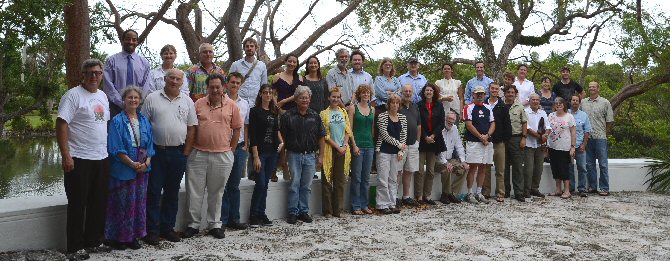
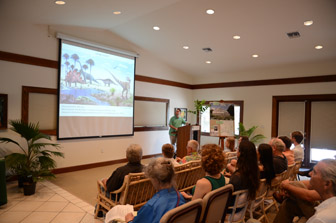 On
Saturday, April 14, 2012, 19 talks and 10 posters were presented at the
Plant Biologists of South Florida Meeting at Montgomery
Botanical Center.
On
Saturday, April 14, 2012, 19 talks and 10 posters were presented at the
Plant Biologists of South Florida Meeting at Montgomery
Botanical Center.
The Plant Biologists of South Florida are a
group of scientists who meet informally once a year to share
discoveries, speculations, and fellowship. Members are held together by
a common interest in plant biology—making this a very diverse group of
plant people.
One of the speakers, Dr. Barry
Tomlinson, offered feedback which nicely summarized the meeting. He
related how frequently meetings focus intensely on a single topic in a
narrow field—but that "the best thing about this meeting is that it is
SO diverse. It is very engaging and interesting because there are so
many different topics."
Montgomery was happy to host so
many longtime friends and colleagues—and make a lot of new friends—at
this unique botanical gathering.
April 2012
Spring/Summer
2012 Montgomery Botanical News is Now Online!
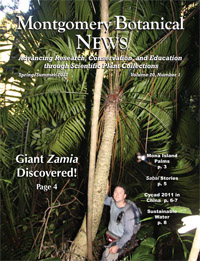 This new
issue has articles about a new Giant Zamia, and discusses
fieldwork in Florida, Texas, Colombia, and on the Island of Mona. It
also highlights The
9th International Conference on Cycad Biology in Shenzhen, China.
This new
issue has articles about a new Giant Zamia, and discusses
fieldwork in Florida, Texas, Colombia, and on the Island of Mona. It
also highlights The
9th International Conference on Cycad Biology in Shenzhen, China.
Montgomery Botanical Center also
presents the two new Conservation Horticulture Fellows and the high
school intern from the Miami-Dade County Public Schools Career
Experience Opportunity Program.
Montgomery Botanical Center
publishes two newsletters a year to keep our supporters and
collaborators up to date and informed.
To read more about how
Montgomery Botanical Center meets our mission of "Advancing Research,
Conservation, and Education through Scientific Plant Collections"
please see our newsletters
online.
March 17th & 18th, 2012
South Florida Palm Society 2012
Spring Palm Show & Sale at MBC
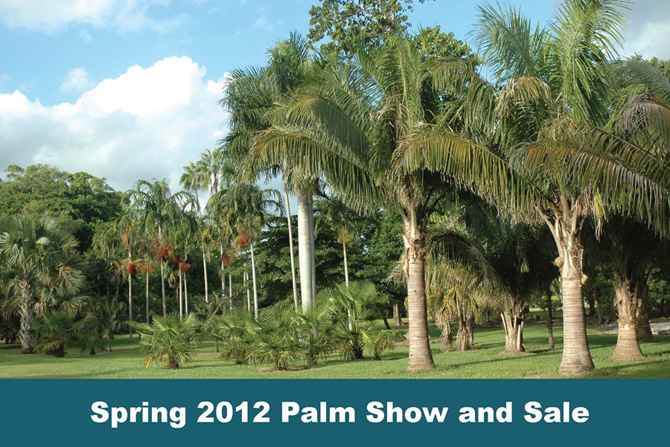
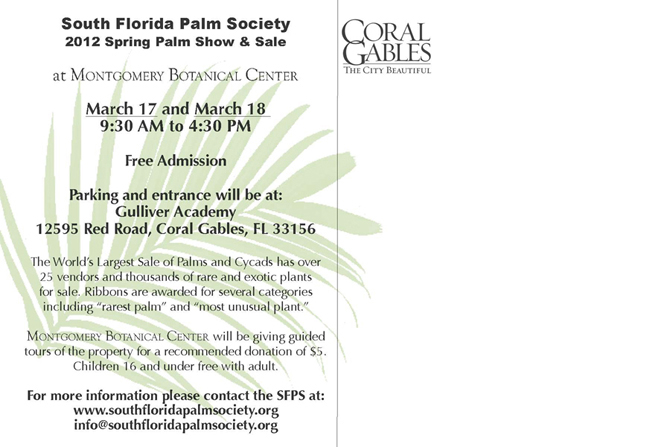
March 14, 2012
Carlos G. Martel to Give Talk on
Scent Producing Organs in the Palms
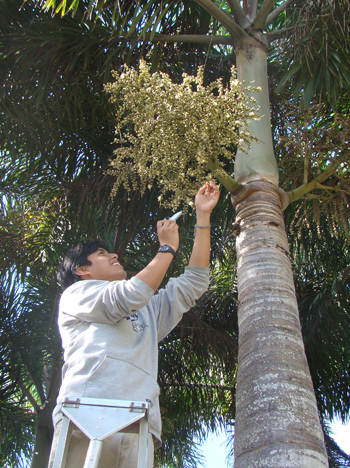 On
Wednesday, Carlos Martel from Museo
de Historia Natural Javier Prado Universidad Nacional Mayor de San
Marcos, Perú will be giving a lecture on his preliminary
analysis of scent-producing organs in the palm family (Arecaceae).
On
Wednesday, Carlos Martel from Museo
de Historia Natural Javier Prado Universidad Nacional Mayor de San
Marcos, Perú will be giving a lecture on his preliminary
analysis of scent-producing organs in the palm family (Arecaceae).
When: March 14,
2012 at 2pm
Where: Montgomery
Botanical Center at The Nixon Smiley Building
What: Floral
adaptations to attract and reward pollinators play a key role with
respect to reproductive success in animal-pollinated plants. Floral
scents act as secondary floral attractants to pollinators, announcing
the presence and location of primary rewards (nectar, pollen etc.). The
flower organs engaged in scent production may be represented either by
an undifferentiated epidermis or more specialized arrangements such as
osmophores or scent glands. Scent glands possess the ability to emit
volatiles and are usually parts of floral organs. They can be found in
the inflorescence or flowers, such as in parts of petals or anthers. A
fairly large number of palm species have been analyzed for floral
scents. They display a wide diversity in form and anatomy of their
inflorescences, bracts and floral organs. However, no study has focused
to date on the location and identification of scent-producing
structures in inflorescences or flowers. I will present preliminary
results of a survey on this subject and what their relationship is with
the palm pollination mechanism.
Carlos' research visit to MBC is
generously sponsored by the Kelly Botanical Research Fellows Program,
through a grant from the Kelly Foundation.
March 10, 2012
Montgomery
Botanical Center and HistoryMiami Celebrate William Lyman Phillips
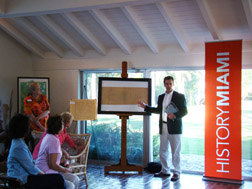 On
March 10, 2012, HistoryMiami
and Montgomery Botanical Center jointly hosted an Inside the Vault
event showcasing the work of William Lyman Phillips and his work in
South Florida and Montgomery Botanical Center. HistoryMiami and MBC
brought original plans and correspondence of William Lyman Phillips
from both archives for this event.
On
March 10, 2012, HistoryMiami
and Montgomery Botanical Center jointly hosted an Inside the Vault
event showcasing the work of William Lyman Phillips and his work in
South Florida and Montgomery Botanical Center. HistoryMiami and MBC
brought original plans and correspondence of William Lyman Phillips
from both archives for this event.
Two talks were given: One by the
Chair of the FIU School of Architecture
John Stuart on William Lyman Phillips South Florida landscape designs
and the second talk was given by MBC Executive Director Patrick
Griffith on the landscape William Lyman Phillips developed at
Montgomery Botanical Center. Last year, Lee Anderson and Patrick
Griffith published a paper
on that subject, documenting Phillips' work at Montgomery.
After the talks, a tour of the
property was given. Guests were able to see legacy of William Lyman
Phillips’ design, and the palm and cycad collections of national
significance that MBC is known for.
March 6, 2012
Fairchild
Challenge Brings Students to MBC for Environmental Immersion Day
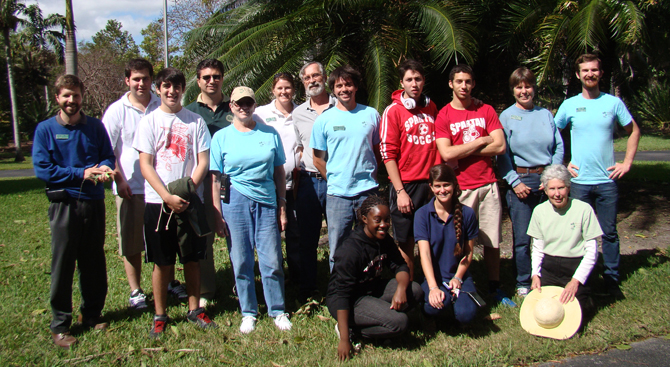
Six students from Miami Country
Day High School visited Montgomery Botanical Center as part of the
Fairchild Challenge’s Environmental Immersion Day.
The students alongside their
teacher, Mr. Tom Sverkounos, participated in activities focused on
cycad biology with four rotations. Judy Kay taught students about
pollination and seed development of cycads, in theory and practice,
collection of seeds, checking for embryos and viability, and pollen
collection and storage. Vickie Murphy taught students how to plant in
the nursery. Dr. Larry Noblick taught them about different palms at the
garden. Ericka Witcher discussed soils at different sites on the
property and described the soil layers and their properties.
MBC is happy to play a role in
exposing young students to botany and supporting our critical mission
of education.
February 17, 2012
Dr. David
de Laubenfels Lectures on the Origins of the Pine Family at MBC
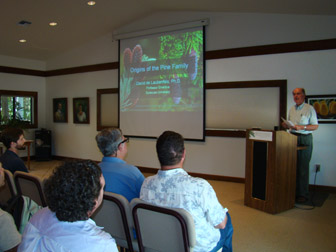 Dr.
David de Laubenfels, Professor Emeritus of Geography at Syracuse
University, New York, presented a lecture on relationships between and
within two very important conifer families: the Cupressaceae (focusing
on our native Florida bald cypress, Taxodium distichum, and
its Southeast Asian relative, Glyptostrobus pensilis) and the
Pinaceae.
Dr.
David de Laubenfels, Professor Emeritus of Geography at Syracuse
University, New York, presented a lecture on relationships between and
within two very important conifer families: the Cupressaceae (focusing
on our native Florida bald cypress, Taxodium distichum, and
its Southeast Asian relative, Glyptostrobus pensilis) and the
Pinaceae.
Dr. de Laubenfels is the world
authority on tropical conifers, especially in the South Pacific. He is
also an authority on the genus Cycas. In addition to botany,
Dr. de Laubenfels has published papers in geography, linguistics and
anthropology, and pursues interests in physics and cosmology.
During his visit to South
Florida, David studied the large tropical conifer collection at MBC.
February 4, 2012
Nick
Dominguez Completes Eagle Scout Project at MBC
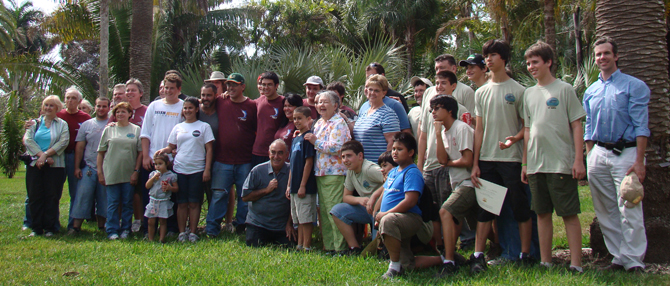
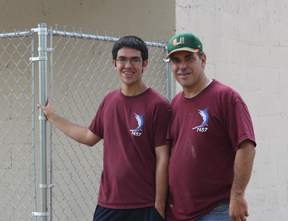 On
Saturday, Nick Dominguez from Troop 457 completed his Eagle Scout
project at Montgomery Botanical Center. Over 79 people worked on the
project, volunteering nearly 500 hours of time.
On
Saturday, Nick Dominguez from Troop 457 completed his Eagle Scout
project at Montgomery Botanical Center. Over 79 people worked on the
project, volunteering nearly 500 hours of time.
Nick managed the construction of
a outdoor storage structure and a fence around Montgomery Botanical
Center’s original well house on the south side of the property. Troop
457 also spread over 2,000 lbs of mulch near the well house. They also
planted some vines around the structure, to help integrate it into the
landscape.
Montgomery Botanical Center is
grateful for the help of Nick, all the Scouts and their families—500
hours of service puts our work very far ahead, and the in-kind value of
these improvements is enormous.
February 1, 2012
MBC Donates Plants and Seeds to Zelda
Glazer Middle School
 On
Wednesday, Montgomery Botanical Center donated 34 plants and many seeds
to Zelda Glazer Middle School
for their Native Wildlife Habitat. Ana Casanova, a science teacher at
Zelda Glazer Middle School, has been engaging her students in planting
a vegetable garden and a native Florida wildlife habitat. They
are building an outdoor classroom and they even have their own
greenhouse.
On
Wednesday, Montgomery Botanical Center donated 34 plants and many seeds
to Zelda Glazer Middle School
for their Native Wildlife Habitat. Ana Casanova, a science teacher at
Zelda Glazer Middle School, has been engaging her students in planting
a vegetable garden and a native Florida wildlife habitat. They
are building an outdoor classroom and they even have their own
greenhouse.
Montgomery donated 25 Zamia
floridana plants, 9 Sabal minor plants, wild coffee
seeds, and silver palm seeds to the school. The students were
excited to have so many new plants for their wild habitat.
Supporting science
education—through living plant collections—is at the core of Montgomery
Botanical Center’s mission.
“It was great to see so many
young students excited about all the new plants they will be adding to
their garden,” Tracy Magellan said. “Zelda Glazer Middle School is a
new school, opening in 2007, so there is a lot of space to grow a plant
collection. Seeing the school actively support gardening by investing
in a greenhouse and an outdoor classroom is inspiring.”
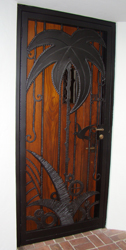 January
31, 2012
January
31, 2012
The Villagers Support Nell’s House
Front Entrance Restoration
The Villagers
awarded MBC a grant to support the restoration of the iconic entrance
to Nell’s House. Many early photos and videos were taken using the door
as a backdrop. Constructed in 1932, the wrought iron door was intended
as a symbol of Montgomery's love for palms and cycads, and through this
restoration funded by The Villagers, the door can continue to symbolize
MBC’s dedication to its palm and cycad collection.
The Villagers are dedicated to
the restoration and preservation of historic sites. They have supported
numerous projects
here at Montgomery Botanical Center. The most recent projects have
supported the restoration of the Arthur Montgomery Guesthouse. Thanks
to The Villagers, the doors are restored and are looking beautiful once
again – just in time for the 80th anniversary of both the Nell’s House
door and the plant collection it represents!
January 28, 2012
NSF Cycad Biology Teachers Workshop
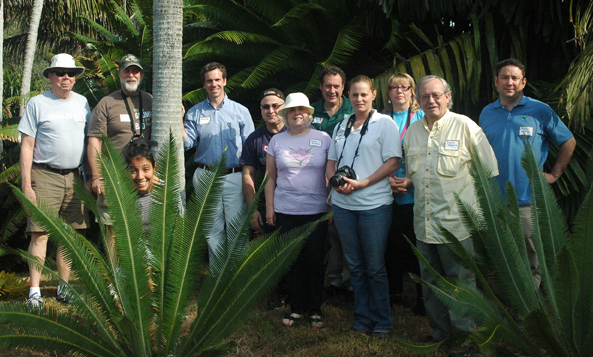 On
January 28th, New York Botanical Garden,
Florida International University,
Fairchild
Tropical Garden, and Montgomery
Botanical Center offered a Cycad Biology Course to teachers from Miami-Dade County Public Schools.
The course was sponsored by the National
Science Foundation and taught by Dennis Stevenson (NYBG), Michael
Calonje (MBC), Javier Francisco-Ortega (FIU-Fairchild), and Patrick
Griffith (MBC).
On
January 28th, New York Botanical Garden,
Florida International University,
Fairchild
Tropical Garden, and Montgomery
Botanical Center offered a Cycad Biology Course to teachers from Miami-Dade County Public Schools.
The course was sponsored by the National
Science Foundation and taught by Dennis Stevenson (NYBG), Michael
Calonje (MBC), Javier Francisco-Ortega (FIU-Fairchild), and Patrick
Griffith (MBC).
Six high school teachers and
Shelley Cant, Education Officer from the Bahamas
National Trust, attended the course. NYBG, FIU, FTBG, BNT,
and MBC have been working together to research the genetics of Zamia
in the Caribbean. Educational outreach is an important component of
this project and the organizations involved are working to make the new
information from this project available to the community.
The workshop included: field
components using the living collections of MBC and classroom lectures
and laboratory demonstrations at the Center for Tropical Plant
Conservation of Fairchild.
“It’s great to see the
enthusiasm our local science teachers new have for the latest cycad
research,” said Griffith. “The interface between current botanical
science and current education is critical.”
January 23, 2012
Fieldwork for
a rare palm on Mona Island
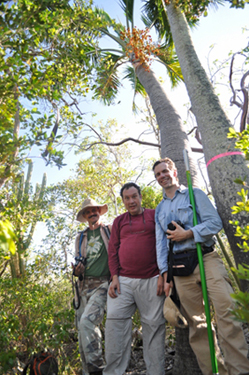 Montgomery
Botanical Center and collaborators recently conducted a field project
in search of a rare palm on Mona Island.
Montgomery
Botanical Center and collaborators recently conducted a field project
in search of a rare palm on Mona Island.
Pseudophoenix
sargentii is found in many places in the Caribbean Basin,
including the Florida Keys – where it is known as the Buccaneer Palm.
Where it does occur, the populations tend to be small, with only a few
palms in each place.
Mona
is a remote, uninhabited island halfway between Puerto Rico and the
Dominican Republic. Over the years, reports from Mona Island varied.
Some counted two dozen Pseudophoenix palms, some claimed fewer
– one alarming report claimed only one palm was left!
A grant from
the International Palm Society
sent four botanists to study and conserve this treasured plant. Patrick
Griffith (from MBC) and Javier Francisco-Ortega (FIU and FTBG) teamed
up with Eugenio Santiago (Botany Professor at UPR), and Jose Sustache,
(DNRA Botanist) for the project.
Over several
days of fieldwork, the team thoroughly documented these rare palms on
Mona Island – making specimens, detailed notes, and photographs – and
collected seeds for conservation. This work can lead to better
understanding and protection of other Pseudophoenix
populations as well as the Mona Island palms.
January 1, 2012
A New “Giant Zamia” Discovered:
Zamia tolimensis
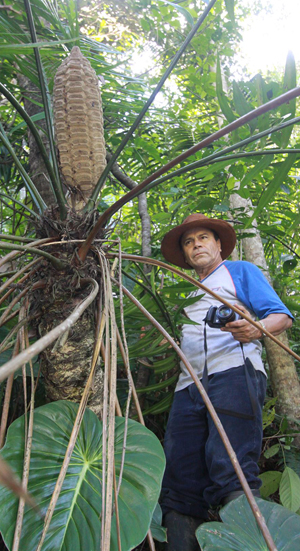 Montgomery
begins the New Year with an exciting new discovery — a new species of cycad, Zamia
tolimensis, from the “Cordillera Central” mountain range of
Colombia. This new species is remarkable for being a large, treelike Zamia
— The leaves can be up to 8 feet
long, with a trunk over 10 feet tall!
Montgomery
begins the New Year with an exciting new discovery — a new species of cycad, Zamia
tolimensis, from the “Cordillera Central” mountain range of
Colombia. This new species is remarkable for being a large, treelike Zamia
— The leaves can be up to 8 feet
long, with a trunk over 10 feet tall!
In describing this very
interesting discovery, Montgomery staff members Michael Calonje and
Claudia Calonje worked closely with colleagues Hector Eduardo Esquivel
and Deicy Pava of the University
of Tolima Herbarium and Dennis Stevenson of the New York Botanical Garden.
Locally, the plants are known
as “palma de yuca”, due to the young stems’ resemblance to the edible
tubers of cassava. The team named the new cycad to honor the Department
of Tolima, where the species is native.
Some intriguing early specimens
hinted at a possible new Zamia yet to be described. Fieldwork
in remote areas of the Colombian highlands in 2011 confirmed that the
plants from Tolima are a distinct new discovery, easily distinguished
from other large South American Zamia species (such as Z.
poeppigiana and Z. lindenii).
This is the first cycad species
discovered in the highlands of the Central Cordillera of Colombia — the native areas where Z.
tolimensis grows are highly inaccessible, perhaps explaining why
such an impressive species remained unknown to science until last year.
Despite remaining inaccessible to researchers for many years, the
plants are considered Critically Endangered due to a high rate of
deforestation throughout their native range.
The formal
description of Zamia tolimensis can be found in the
December 2011 issue of BRITTONIA.
January 2012
MBC's
plant collection turns 80 years old: The Coconut
Grove Palmetum, 1932
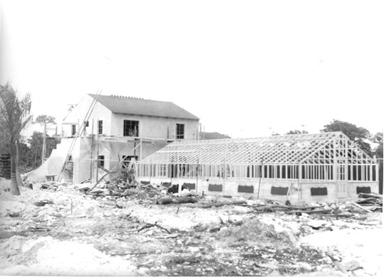 Colonel
Montgomery traveled around Florida in the summer of 1932 buying large
specimen palms from nurseries, growers, and private collectors. The
Colonel obtained specimens of every palm species known to be growing in
Florida at that time — around 150 species in all.
Colonel
Montgomery traveled around Florida in the summer of 1932 buying large
specimen palms from nurseries, growers, and private collectors. The
Colonel obtained specimens of every palm species known to be growing in
Florida at that time — around 150 species in all.
Colonel
Montgomery developed his palmetum with the advice of David Fairchild
and Tom Fennell, of the U.S. Department of Agriculture Plant
Introduction Station at Chapman Field. In that first year, the Colonel
successfully transplanted about 700 specimen palms to the estate — and
named it the Coconut Grove Palmetum.
Before long,
ten acres had been cultivated and 237 palm species (over 1,000 mature
specimens) had been planted in the Palmetum. Col. Montgomery spent a
total of $80,000 on plants, grading, landscaping, and planting during
the first two years. This greatly exceeded the $10,000 he spent for the
property and the $22,000 he spent to build his house.
The Coconut
Grove Palmetum was Colonel Robert Montgomery’s private palm collection
and estate. In 1959, Nell Montgomery renamed the property and
established a not-for-profit in his memory, now known as Montgomery
Botanical Center.
Over the course
of 80 years, the Colonel's Palmetum has now developed into a thriving
center for botanical research and conservation — and MBC looks forward
to further good work.
For details of
MBC’s early and recent history, please visit the History
Page, browse our Newsletters,
and also see our News
Archives.



